HUMANS' RACE
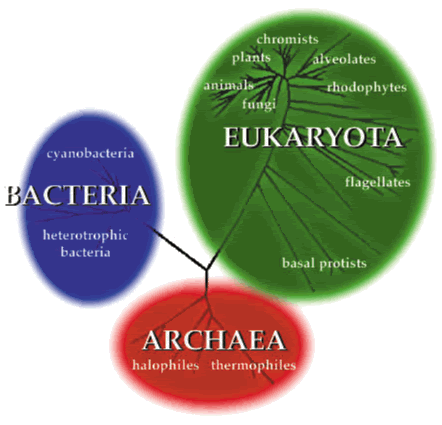
I have just added the most recent article about Life on Mars. It is at the bottom of this page. Please look at it...
Sometimes, I am SO right I scare myself.
**********************************************
You and I are members of the Eukaryota; our cells have the organelles and nuclei to confirm this. Organelles and nuclei are not present in the other two groups. Does that mean that Archaea and Bacteria are more closely related to each other, or could it be that one of these two groups is more closely related to eukaryotes? It turns out that you (as a eukaryote) are more closely related to Archaea than to Bacteria.
Gee. Who'da thunk it?
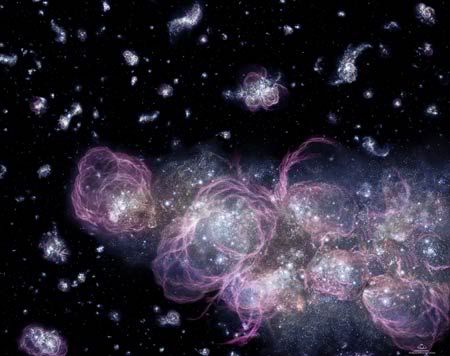
Isolated and characterized set of thermo-sensitive Sulfolobus acidocaldarius mutants. These are the first conditional-lethal mutants that have been described for any archaeon or hyperthermophile. Furthermore, we have discovered that in several euryarchaeal species, including Methanocaldococcus (Methanococcus) jannaschii, the cells contain multiple chromosome copies. In an extension of our work to include halophilic archaea, the ftsZ cell division gene of Haloferax mediterranei has been isolated. We have also studied chromosome replication patterns and replication origin locations in Archaeoglobus fulgidus and M. jannaschii using marker frequency analysis.
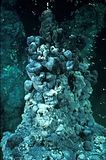
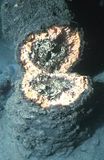
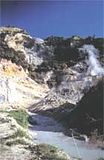
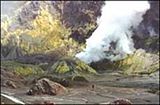
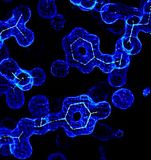
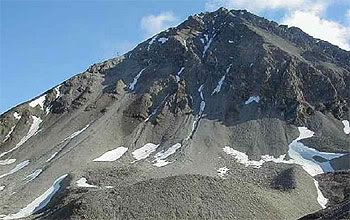
Research Team Discovers First Evidence of Microbes Living in a Rock Glacier Rock glacier, photographed at the Niwot Ridge Long-Term Ecological Research site.
December 13, 2004
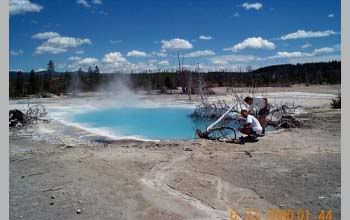
Archaea adapted to live in extreme environments, such as the hot springs in Yellowstone National Park.
New Map Reveals Hidden Features of Ice-buried Antarctic Lake
Measurement shows that two distinct ecosystems may exist.

Scientists from the Lamont-Doherty Earth Observatory (LDEO) at Columbia University and Rensselaer Polytechnic Institute in New York State have developed the first-ever map of water depth in Lake Vostok, which lies between 3,700 and 4,300 meters (more than 2 miles) below the continental Antarctic ice sheet. The new comprehensive measurements of the lake—roughly the size of North America's Lake Ontario—indicate it is divided into two distinct basins that may have different water chemistry and other characteristics. The findings have important implications for the diversity of microbial life in Lake Vostok and provide a strategy for how scientists study the lake’s different ecosystems should international scientific consensus approve exploration of the pristine and ancient environment.
The new measurements are significant because they provide a comprehensive picture of the entire lakebed and indicate that the bottom of the lake contains a previously unknown, northern sub-basin separated from the southern lakebed by a prominent ridge.
Using laser altimeter, ice-penetrating radar and gravity measurements collected by aircraft, Studinger and Robin Bell, of LDEO, and Anahita Tikku, formerly of the University of Tokyo and now at Rensselaer Polytechnic Institute, estimate that Lake Vostok contains roughly 5400 cubic kilometers (1300 cubic miles) of water. Their measurements also indicate that the top of the ridge dividing the two basins is only 200 meters (650 feet) below the bottom of the icesheet. Elsewhere, the water ranges from roughly 400 meters (1,300 feet) deep in the northern basin to 800 meters (2,600 feet) deep in its southern counterpart.
The scientists also point out that the waters of the two basins may, as a result of the separation, have a very different chemical and even biological composition. Indeed, Lake Vostok, is also of interest to those who search for microbial life elsewhere in the solar system. The lake is thought to be a very good terrestrial analog of the conditions on Europa, a frozen moon of Jupiter. If life can exist in Vostok, scientists have argued, then microbes also might thrive on Europa.
Yep. They just Might at that.
The oldest fossils of bacteria/archaea are 4 billion years old.
The oldest multi-celled creatures, like jelly-fish, are 500 million years old.
The earliest signs of humans are 200 thousand years old.
Bacteria, aka Archaea, to complex cells-
around 2.5 billion years
Cells to colonies (or bodies), where cells become specialized for handling different things for the body as a whole-
an unknown period of time.
The development of a nervous system (intelligence)-
this process seemed to be finished by the time when the dinosaurs roamed freely.
Intelligence to mammals and Homo Sapiens-
this process seemed to take 250 million years on Earth.

Some of the colorful thermophiles...
(heat loving organisms: algae, bacteria and Archaea) which grow in the hot water (up to 160F, 71C) that flows out from the geysers.
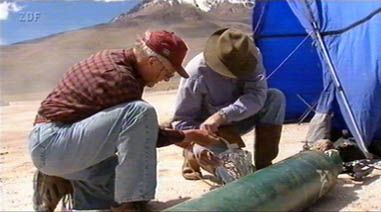
Dieter Söll and Karl Stetter collect archaea on a Chilean mountain top.
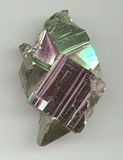
Geochemical constraints on the ecology of some of the deepest lineages within the Bacteria and Archaea.

Yellowstone's Microbes
Labelling tubes and waiting for the next measurement during a blizzard at "Shark Spring"*, Calcite Springs, Yellowstone National Park.
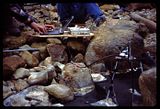


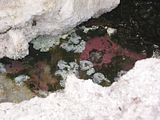
CYANOBACTERIA (ARCHAEA)

First discovered in Thai rice paddies, the microbe known as Heliobacillus mobilis belongs to a group of bacteria called Heliobacteria. These bacteria respond to light and contain a form of chlorophyll that is intermediate to that found in green plants and cyanobacteria-the first bacteria to release oxygen on earth. Some scientists believe that early forms of cyanobacteria used energy from sunlight to transform the earth's atmosphere into an oxygen-rich blanket suitable for animal life.
Structural similarities between the two bacteria suggest the possibility that the Heliobacterium chlorum microbe could be the direct descendant of the ancient bacterium that produced cyanobacteria.
Further evidence to support this possibility includes the comparison of molecules called ribosomal RNA that are found in Heliobacteria and other microbes. Ribosomal RNA, which plays a crucial role in making proteins, has evolved slowly over the years. The type found in Heliobacterium chlorum closely matches the ribosomal RNA found in some older bacteria that do not respond to light, yet the RNA are strikingly different from that residing in other, more common light-sensitive bacteria. The Heliobacterium chlorum related to both cyanobacteria and older more primitive microbes seems clearly marked as an evolutionary link.
JUST DAMN!!!
(Obviously, what science considers LIFE is limited to what it thinks it is, not what is.) I guess those old *primitive* microbes that have built virtually everything never were life although life as we know it and life we DON"T know yet, could never have existed without it, and have no future in the entire cosmos. Still, life is expanding in the cosmos faster than we can read all the data being sent back. What they can't explain, they hide and that makes me angry. Denial of truth is worse than a lie. Science lies and swears to it. And though happenstance sometimes allows breakthroughs, there is no understanding as to why or how...only that they tried one thing and got something unexpected. Science will not and cannot tell you our origins because if they had nothing to do with it, it couldn't have happened...even with proof.
FLORIDA
The conditions at Jewfish sink representing a transition from a freshwater to a marine system are similar to those proposed for a large sediment-filled sink in the Florida Keys (Shinn et al. 1996). My graduate student (Michael Garman) and I have measured dissolved oxygen, temperature, sulfide, nitrate, ammonia and conductance while exploring the sink using SCUBA on a series of dives approximately every other month for the past 18 months. Our preliminary observations can be summarized as follows: The water in the sinkhole appears to be stagnant except for the annual sinking of cold surface water during the winter. By summer, the sink may reach an equilibrium in which sulfide production driven by organic carbon oxidation in the anoxic bottom water is in equilibrium with oxygenated surface water. The sink becomes a diffusion system in which oxygen diffuses downward from the surface where the water is in equilibrium with the atmosphere, and sulfide diffuses upward from the bottom water where sulfate reduction occurs. Both oxygen and sulfide concentration are near zero at the chemocline. Sulfide measurements in the water below the chemocline range from 1 to 15 mg/L, while nitrate and ammonia range from 1 to 6 mg/L. The sulfide below the chemocline appears to support two communities of sulfur oxidizing bacteria as evidenced by two pH minima.
There is an upper community at the chemocline that likely uses oxygen as an electron acceptor and a second community below the chemocline that likely uses nitrate as and electron acceptor. The density relationships between the two sulfur oxidizing bacterial communities and the concentrations of oxygen, sulfide and nitrate can be expressed as a series of diffusion equations with initial concentrations of sulfide and nitrate dependent on the flux of organic carbon in the sinkhole There are extensive bacterial mats in the anoxic regions of Jewfish Sink that support both prokaryote and eukaryote microorganisms.
We have collected samples from the water column in Jewfish sink from several depths above and below the chemocline as well as samples of sediment and bacterial mats. We have amplified 16S rRNA genes with eubacterial primers (Lane 1991) and cloned libraries of the 16S amplicons. We currently have several hundred independent clones from the different samples and have begun to sequence them with the intent of identify the members of the bacterial communities present in the Jewfish system by phylogenetic analysis with known sequences from Genbank. We are just beginning to repeat the process with primers specific for Archaea .
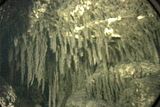
The sediment on horizontal ledges and fissures within and around the mouth of Jewfish spring support what appears to be a thriving community of nematodes and other meiofaunal animals. Meiofauna are microscopic animals between 50 and 500 microns in length and have been used as indicators of biodiversity (Kennedy and Jacoby 1999). The only macrofaunal invertebrates appear to be some encrusting sponges. Because of the high sulfide levels in these sediments, we suspect that the meiofauna are sulfide tolerant and it is likely that some of them have bacterial symbionts (ref). Hand sorting and identification of meiofauna is tedious and requires expertise that few scientists possess so we are taking a molecular approach to meiofauna similar to the approach for bacteria. To measure the biodiversity of the meiofaunal community, Melissa Adorno, an undergraduate in the lab has extracted DNA from the sediment and amplified metazoan 18S rRNA genes.
Scientists Discover Methane Ice Worms on Gulf of Mexico Sea Floor
"It's very cool that while we're busy speculating about life on other planets we continue to discover new forms of life in the most unlikely habitats on Earth," commented Erin McMullin, a Penn State graduate student and a member of the research expedition that discovered the methane-ice worms. Methane ice, a gas hydrate, forms naturally at the high pressure and low temperature of the deep sea, but is usually buried deep in marine sediment. The Gulf of Mexico is one of the few places where hydrate can be found exposed on the ocean bottom. Occasionally this seeping, solid methane bursts through in mounds, often six to eight feet across.
Very cool? Oh my!
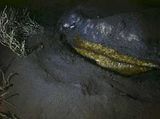
Methane hydrates are mounds of ice (crystallized structures of methane & water) that can form under conditions of low temperature and high pressure. This methane hydrate mound (right side of photo), discovered by Charles Fisher 700 meters deep in the Gulf of Mexico, is over 6 feet in diameter and has thousands of polychaete worms living on its exposed surface. The structures on the left side of the photo are tube worms.
(Photo credit: Charles Fisher, Penn State)
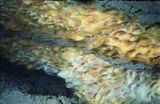
This close-up photo shows a dense colony of one-to-two inch-long polychaete worms living on and in the surface of the methane hydrate. These worms were discovered on July 15th 1997, by Penn State Associate Professor of Biology Charles Fisher and his research team, which is just beginning to study them. They speculate that the worms may colonize the hydrates even when they are buried and that the worm's nutrition is tightly tied to the hydrate itself.
(Photo credit: Charles Fisher, Penn State)
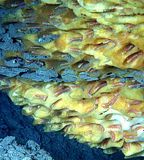
And THIS is just ONE of THESE:
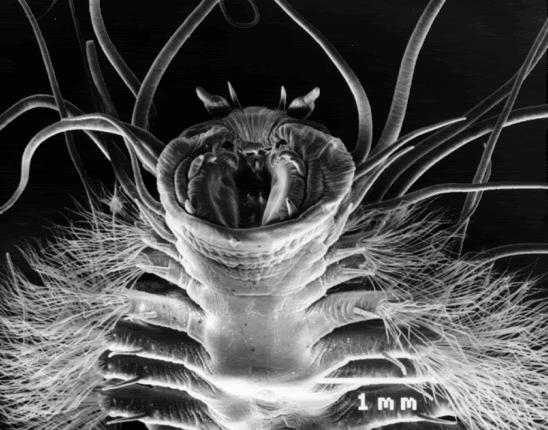
Bioluminescent organisms
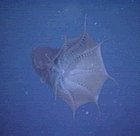



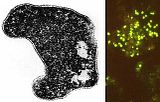
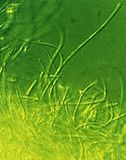

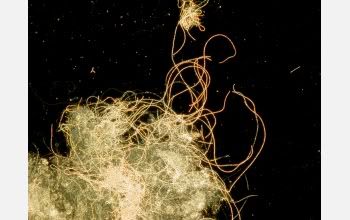
Microscopic photo of metal-oxidizing bacteria found in biofilm samples taken from a South African gold mine.
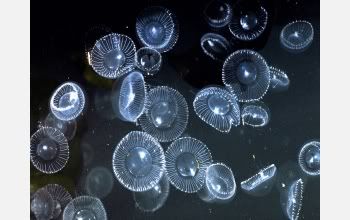
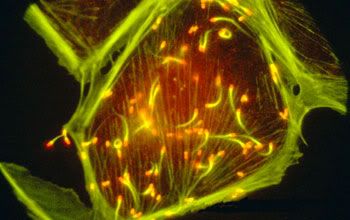


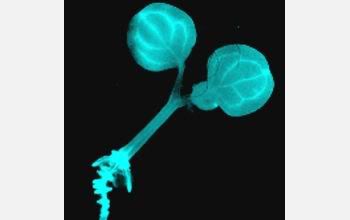

STILL MORE: Pristine Water...
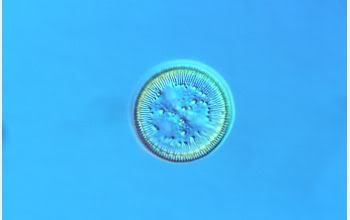
The Cyclotella ocellata species of diatom pictured here is the most common planktonic diatom in Lake Hovsgol, Mongolia. Diatoms are a large group of microscopic algae that grow as single cells or small colonies. The lake is estimated to be over 1.6 million years old.
Dr. Edlund's team discovered that a number of species originally described were still alive and well in Lake Hovsgol. And a number of diatoms were endemic to that lake. He confirmed the results by taking a sediment core of material from 150 years ago. He found the same species complex existed in both the core samples and in the lake today.
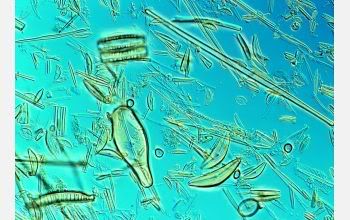
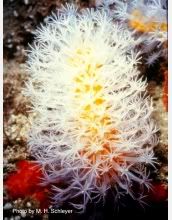
DNA Components:
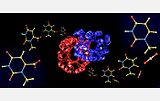
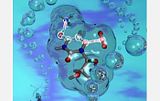
This computer-generated image depicts a molecule reacting to form a DNA base.
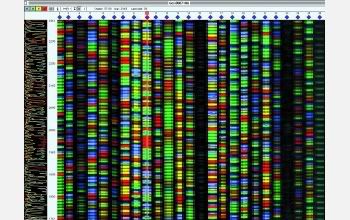
Model of esperamicin A1 with the warhead portion displayed in orange.
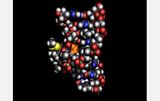
WILLIAM BROAD, Author, The Universe Below: Everest is about five miles. So it’s going much deeper than the highest mountain on Earth in these deep trenches. And we know virtually nothing about it. Scientists estimate that in the huge dark biosphere that we’re talking about we might have laid eyes on maybe a hundredth or a billionth of it. It’s just a tiny, tiny fraction of what’s out there.
DAVID GERGEN: So what they’re looking for as they go to Mars and Jupiter--there’s a landing coming on Mars this July 4th--with the Explorer--they’re looking for water; they’re looking for signs of life.
WILLIAM BROAD: They’re looking for water. Yes. If you have liquid water, you get--the chances for life, by all estimates, are great. And that’s what they’re--that’s what they’re interested in.
DAVID GERGEN: So they could find the origins of life, itself, somewhere out there?
This image shows a giant star-forming region in the southern sky known as the Carina Nebula (NGC 3372), combining the light from 3 different filters tracing emission from oxygen (blue), hydrogen (green), and sulphur (red). The color is also representative of the temperature in the ionized gas: blue is relatively hot and red is cooler. The Carina Nebula is a good example of how very massive stars rip apart the molecular clouds that give birth to them. The bright star near the center of the image is Eta Carinae, which is one of the most massive and luminous stars known. This picture is a composite of several exposures made with the Curtis-Schmidt telescope at the Cerro Tololo Interamerican Observatory (CTIO) in Chile.
This image is one of the first images ever taken of atomic bonding. The image shows the electronic bonds that hold together atoms of oxygen and copper in a compound called cuprite.
They SEE it but don't believe it. Science. Hoo, boy!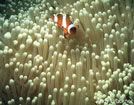
SOMEWHERE...OUT THERE
ONE MORE *IMPOSSIBLE THING.*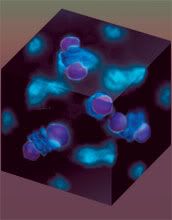
This image represents the first time the covalent bonds between atoms have ever been "seen" in cuprite. The invisible nuclei of the copper atoms are at the center of the dumbbells. Nuclei of the oxygen atoms are at the center and corners of the superimposed cube. The fuzzy green clouds are less defined electron clouds representing covalent bonds between the copper atoms.
Many chemists do not believe that such metal-to-metal bonding can occur in the material. Cuprite is a superconductor and like many similar metal oxides, it has strange electrical properties that may now be explained by these never-before-seen bonds. The work may have broad implications for new materials used in computer compounds, medical equipment and other devices.
SOMEWHERE DOWN HERE: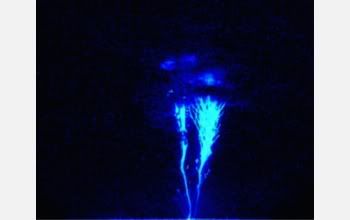
A team of researchers at the Natoinal Science Foundation's Arecibo Observatory have captured video evidence from the ground of a lightning phenomenon known as a blue jet. The discovery is the first ground-based evidence linking the ionosphere with cloud tops in blue jet events.
According to Victor Pasko of Penn State, an electrical engineer working at Arecibo, "Pilots and others reported observations of red sprites and blue jets long before the first one was captured on video, and numerous undocumented reports of similar phenomena have appeared in scientific literature for over a century."
Blue jets develop at cloud tops at 12 to about 26 miles. They appear blue to the naked eye, last for up to several hundreds of milliseconds, and are cone-shaped. According to Sunanda Basu, program director in NSF's Division of Atmospheric Sciences, which funded the research, the video is the first ground-based evidence of a direct electrical discharge from a thundercloud top to the lower edge of Earth's ionosphere. The electrical contact may represent an important component of the global electrical circuit, says Basu.
The event was recorded using a monochrome low-light video system, but the researchers all agree that the phenomena was seen visually as blue in color. The top of the jet appears to look much more like a red sprite than a blue jet, with hot spots and a fuzzy diffused appearance. Scientists do not yet know if this is a new phenomenon.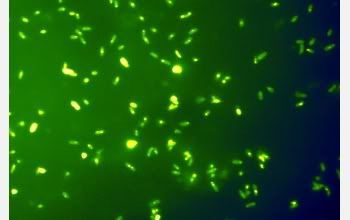
Surfactants--or surface-active agents--are substances that lower the surface tension, a membrane-like barrier between different liquid phases that affects the ability of molecules to move from one phase to another. In addition to synthetically produced surfactants, these substances are also produced by a wide diversity of microorganisms. Some types of "biosurfactants" can bind tightly to toxic metals such as lead and cadmium. Some types can adhere strongly to surfaces, sometimes completely changing the properties of the surface.
We want to (1) discover how much of the class of biosurfactants known as rhamnolipids are produced in soil; (2) discover how these rhamnolipids complex toxic metals such as lead and cadmium; and (3) determine how these biosurfactants interact with soil surfaces in the presence and absence of metals.

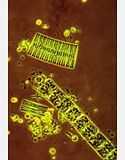

Algae Beds in Tranantarctic Dry Valleys.

Well. What DO they know?
By now you might think they WOULD know that without ALL of the above and zillions more just as diverse, what comes after would never have been possible. Nano technology is frankly nothing more than the use of already present building blocks, (Archaea,) in a different setting. It is Archaea adapting to its surroundings by whatever means, but it is not the creation of new life. Yet some idiot scientist is trying to fleece the public for money to CREATE a complete and new LIFE from what he perceives as nothing. The insane become more insane.
Now we know water is not the be all and end all for life out there. The trouble is, will science accept life even if it isn't like us? Will they call it life and allow it to proceed as it should, or will they, as I hear is being speculated by armchair space cowboys, *inject* greenhouse gases onto a planet that already has thriving life which might be destroyed?
This isn't science. It would be abuse of the cosmos and a prime example of our vanity. There are other places out there that could be perfectly suited to us, but we'll never get the chance to find it if we try to murder everything in our line of tunnel vision. We have been given the opportunity to learn the majesty of what is. After all, something is keeping our little machines in perfect working order. We are not Archaea that can live in any environment. They are all there is. G-d. Creation. We can never create what has already been. But we can do as our parents did in a place they could survive without destroying what was already here when they came. They gave us a part of themselves and a chance to do unto others. But not like this. They will destroy us first. And we will deserve it. The planet can survive without us. We can not survive without IT.

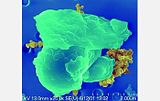
Tetrahedral carbon atom that creates tight and stable bonds to form tiny tubes only six atoms across--the smallest diameter theoretically possible.

A view down the middle of a boron nitride nanotube.
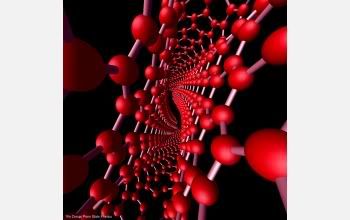
A view from within a flattened twisted carbon nanotube.
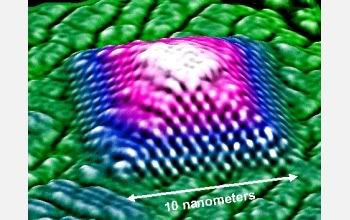
Self assembled Germanium 'pyramid' (base 10 nanometer x 10 nanometer) on Silicon.
The nanoscale pyramid of germanium atoms is formed spontaneously atop a ground of silicon. Each small sphere represents an atom. It would help researchers develop new generations of tinier electronic devices that are govern by quantum phenomena.
Three-dimensional nanostructure grown by controlled nucleation of silicon carbide nanowires on Gallium catalyst particles. As the growth proceeds, individual nanowires 'knit' together to form 3D structures.
Nanometer scale wires (about one thousandth the diameter of a human hair) of a silicon-carbon material (silicon carbide) are grown from tiny droplets of a liquid metal (Gallium) on a silicon surface, like the chips inside our home computers. The wires grow as a gas containing methane flows over the surface. The gas reacts at the surface of the droplets and condenses to form the wires. By changing the temperature and pressure of the growth process the wires can be controllably fused together in a natural process to form a range of new structures, including these flower-like materials.


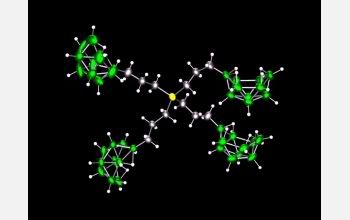
This is a picture of a new cluster molecule involving carbon, silicon, and boron. The compound should be useful as a building block for larger supramolecules. Supramolecules can be built in long chains, or by adding on branches around a central core, or as lego blocks in larger geometric structures.
Say there. Haven't we seen that phrase before?
Like I said. What DO they know?
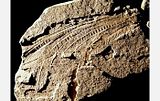
This 220-million-year-old fossil offers evidence that dinosaurs were not ancestral to birds.
An archosaur called Longisquama insignis, a small reptile roughly the size of a mouse, has ignited scientific controversy due to the six vane-like appendages attached to either side of Longisquama's back. Longisquama's lived about 220 million years ago in Asia, during the late Triassic era. Some researchers believe the appendages were non-avian feathers and that early archosaurs were the ancestors of modern birds. Longisquama is controversial because it's not a dinosaur, and most paleontologists believe that birds evolved from dinosaurs.
In 1999, a team of scientists who studied the fossil found arresting parallels between the appendages and feathers, most notably, a hollow shaft with a sheath characteristic of modern feathers. Some scientists believe this shows that the genetic and developmental potential to produce feathers was present in these early archosaurs. The team also reached the conclusion that the feathers weren't used for thermoregulation but likely allowed the creature to glide between trees.
However, many scientists believe that features as specialized as feathers had only one path of evolution so if feathers evolved from Longisquama's, which occupies one branch of the archosaur family (a subclass of reptiles), they are unlikely also to have evolved in another archosaur, like theropods. Paleontologists who do believe that birds evolved from theropod dinosaurs cite skeletal similarities to back up their claim.
Anybody heard about the *new* HIV strain. It ain't new. It's just faster. I keep telling you, time has speeded up.

Magnified approximately 1,700 times with a scanning electron microscope, a group of single-celled algae (euglenophytes) show their ability to change within a second or two. The change is thought to be caused primarily by one of the cell's cytoskeletal components called microtubules.

UMMM. DOES ANYBODY NOTICE THE EXTREME DIFFERENCES IN THE FACIAL AND CRANIAL STRUCTURES OF THIS PAIR?
The only thing that relates them to each other is that they both have eye sockets and teeth. Yet science has displayed them as a pair though the facial and cranial bone structures are totally incompatible.
Where are the thick bony prominences of the skull on the *female*? Where is the wide bony bridge between the mouth and the nose on the female? Where is the protruding bone on the chin of the female? Why does the female's whole face slope gently back and the *male* looks simply gorilla-like? Why is the female cranial cavity so much smaller and the bone looks so much more fragile?
If *science* says these two were human, they have deliberately perpetrated a hoax on themselves. One skull is clearly leaps and bounds ahead of the ape-like skull that looks as if it was formed to butt itself against rocks and fight off falling boulders.

Life? On Mars?
16 February 2005----- 02:09 pm ET
CRIKEY!!!!
SEZ NITZANA
I do not aim to please, I aim to teach...


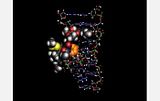

























Home